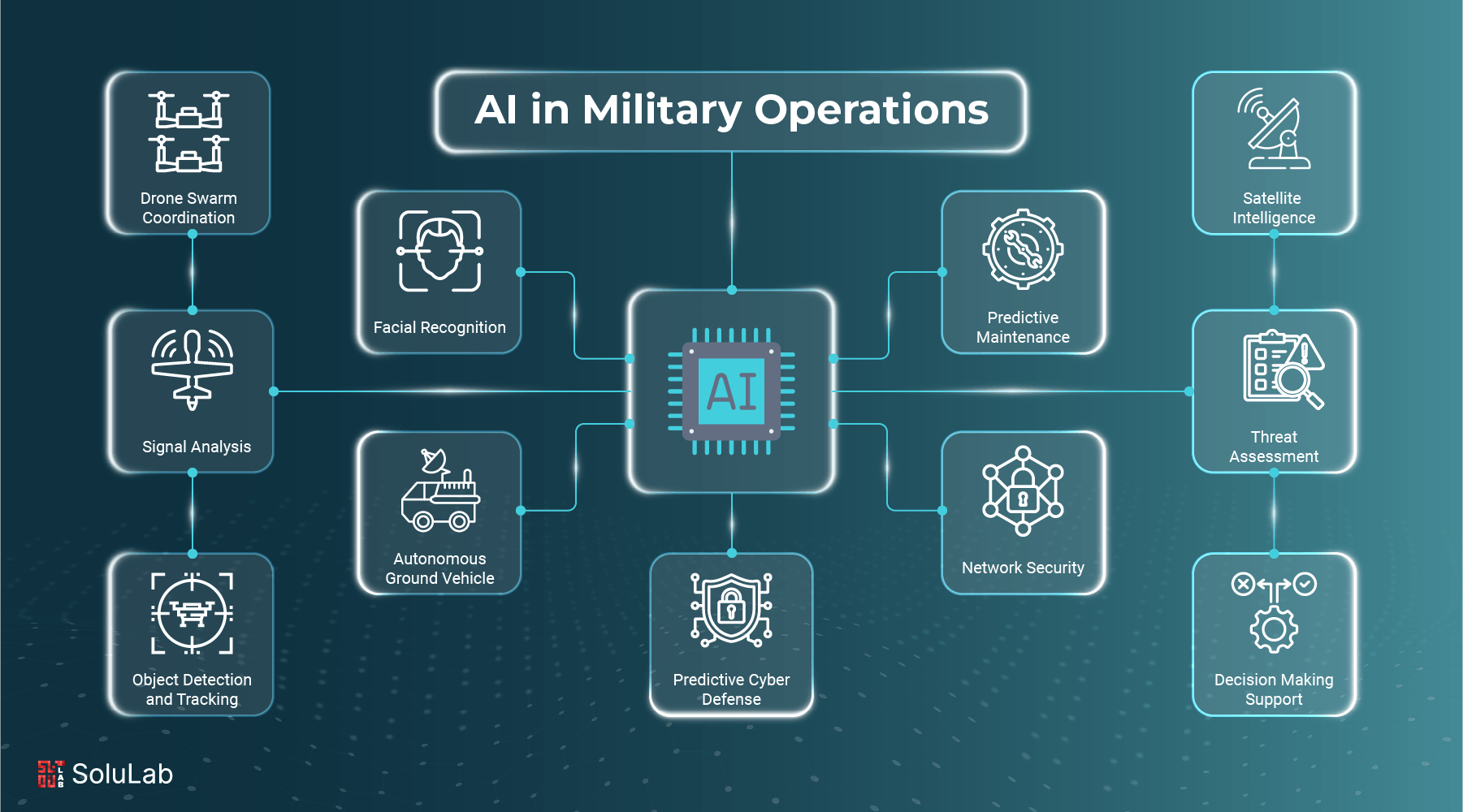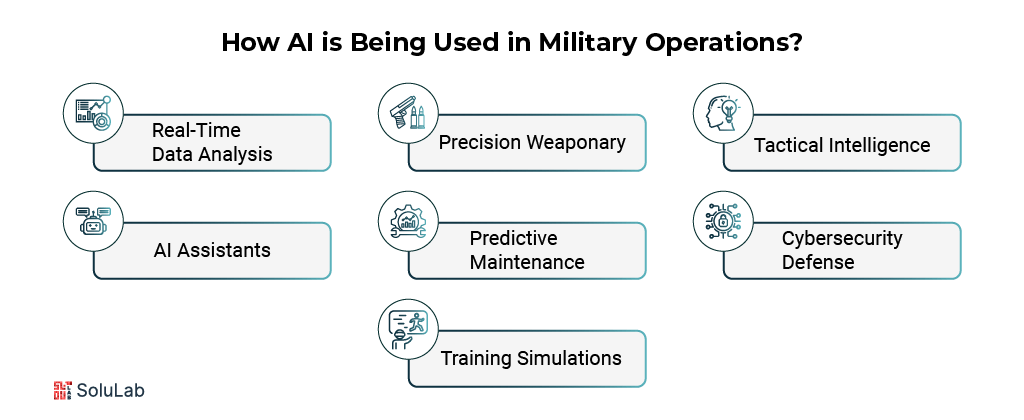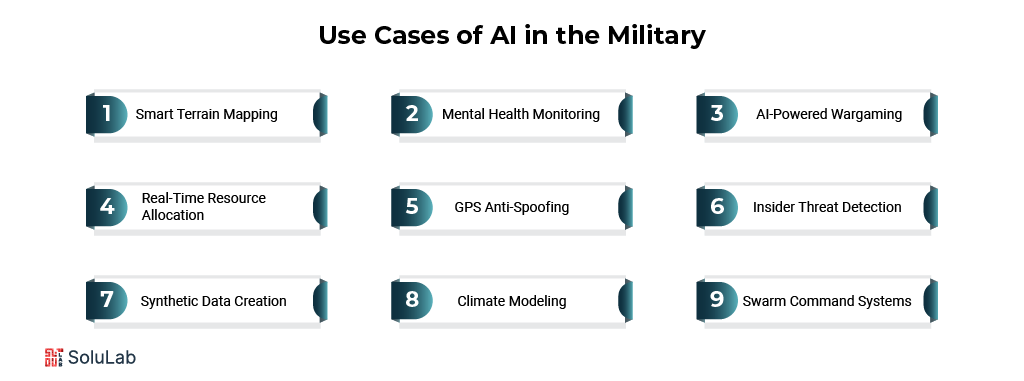
The way wars are fought today looks nothing like the battles of the past. Guns and boots on the ground are still part of the equation, but they’re no longer the whole story. In the background, Artificial Intelligence has become a key element of national defense strategies, which are processing vast amounts of data, operating autonomous systems, and identifying complex threats in real time.
It is not a shock that defense spending on AI is seeing great growth as recent terror attack news trends reflect. According to a report by Markets and Markets, the global military AI market is projected to grow from $9.2 billion in 2023 to $38.8 billion by 2028, at a CAGR of 33.3%.
In our blog, we will look at how military AI is transforming present-day warfare and why its role in modern warfare is no longer a matter of “if,” but “how soon.”
What is AI in the Military Context?
In present times, technology is a large player in what the armed forces do. As we discuss AI in military, we are talking about the use of computer programs and systems that are made to think and learn, which in turn they use to support soldiers and commanders in what they do.
For instance, AI is able to look at field data, identify which threats are on the horizon early on, and put forth the best options for action. This which in turn, allows decision makers to stay ahead and adapt to change without delay.
In this tech, we see the AI agent, which is a type of software or robot that performs certain tasks on its own. If it is flying a drone, monitoring security, or identifying enemy activity, that is what these agents do, which in turn is a support to human effort and the AI bettering of processes. They handle routine or dangerous tasks so soldiers can focus on major goals.
In short, AI is changing how armies prepare and respond by giving them smarter tools to navigate complex challenges.
How AI is Being Used in Military Operations?
The present state of the modern battlefield is in a state of constant change, and technology is at the core of that change. Into that picture comes military artificial intelligence, which has become a game changer among the other technologies; it is what is enabling armed forces to perform with greater precision and efficiency. AI is transforming military operations worldwide from information collection to the support aspect. Here is how military AI tech is playing out in defense today:

1. Real-time Data Analysis: AI in military training, which processes large sets of combat data at great speed and in real time, which in turn gives commanders at the front end quick access to important info that improves their decision making in emergencies.
2. Autonomous Survey: In the area of defense tech, which includes artificial intelligence, autonomous drones, and robotic systems, is used for the task of surveillance. They go into dangerous and remote areas that we can’t send in personnels.
3. Precision Weaponry: Through the development of better targeting systems, artificial intelligence in military weapons, which in turn produces smart missiles and artillery that hit with greater precision and cause minimal accidental damage.
4. Cybersecurity Defense: AI-powered systems that constantly watch over and protect military networks from cyber threats, they also identify incursions at an early stage and react faster.
5. AI Assistants: Through communication and at the same time making info available as soon as it is available, and also by taking care of routine tasks which save time, AI assistants for troops and command.
6. Tactical Intelligence: Using sensor data and satellite images, which are what machine learning models use to track adversary movements, we see that, in turn allows troops to make quick and efficient tactical adjustments.
7. Advanced Training Simulations: AI, which powers virtual environments that replicate real-world combat for training, which in turn adapt to the movement of the troops to increase their preparedness.
8. Improved Logistics: By identifying what resources are needed in advance and see to it that supplies and equipment are quickly delivered to the front lines, military applications of artificial intelligence improve supply chains and logistics.
Through the implementation of these AI-based features, armed forces around the world are improving safety, increasing operational performance, and achieving a competitive edge in complex and dynamic settings.
Benefits of AI in the Military
Artificial intelligence is reshaping the way modern military and warfare operations are conducted, providing numerous strategic and tactical advantages. Let’s explore the key benefits of AI in the military, highlighting how it strengthens capabilities and optimizes resources.
1. Enhanced Situational Awareness
In military and warfare scenarios, quick, accurate decision-making is crucial. AI systems excel at analyzing vast streams of sensor data, satellite imagery, and communications, delivering real-time intelligence that enhances commanders’ situational awareness. This comprehensive insight supports faster and more precise strategic decisions.
2. Improved Security and Defence Readiness
AI enhances security by continuously monitoring threats and vulnerabilities. Machine learning models detect unusual patterns that may signal potential attacks or breaches, allowing forces to act proactively. This capability significantly strengthens defence readiness, ensuring forces can anticipate and neutralize threats before they escalate.
3. Automation of Dangerous and Routine Tasks
Military operations often involve hazardous environments where human lives are at risk. Autonomous drones and robotic vehicles powered by AI undertake surveillance, bomb disposal, and supply transport missions, minimizing soldier exposure to danger. Automating these repetitive or high-risk tasks increases operational efficiency while preserving human resources.
4. Accelerated Intelligence Gathering
AI in military examples include advanced data analytics tools that swiftly process massive datasets. Natural language processing (NLP) capabilities enable systems to analyze intercepted communications, open-source information, and social media intelligence, providing actionable insights with unmatched speed. This rapid intelligence gathering is vital for timely responses.
5. Precision and Effectiveness in Weapons Systems
AI integration in weapons enhances targeting accuracy and operational safety. Smart munitions equipped with AI adjust their flight paths in real-time based on environmental conditions and target movements. This precision reduces collateral damage and maximizes mission success rates, showcasing the evolving role of AI in modern warfare technologies.
6. Advanced Training with AI-Driven Simulations
Military training benefits significantly from AI-powered simulations that replicate battlefield conditions. These immersive environments adapt to individual trainee performance, enabling customized learning experiences. Soldiers gain practical skills and experience without the risks or costs associated with live exercises, improving overall preparedness.
7. Support from Generative AI Chatbots
An emerging benefit in military contexts is the use of generative AI chatbots as virtual assistants. These chatbots can help military personnel by quickly retrieving information, managing communications, and automating administrative tasks. Their 24/7 availability ensures continuous support, allowing soldiers and officers to focus on strategic objectives.
8. Force Multiplication Through AI
The combined capabilities of AI technologies act as a force multiplier, enhancing the effectiveness of military personnel and equipment. By automating complex tasks, providing superior intelligence, and supporting decision-making, AI enables smaller forces to achieve greater impact in warfare scenarios, offering a critical edge in modern conflicts.
Key Use Cases of AI in the Military
The applications of artificial intelligence across several levels of military infrastructure change along with defense technology. Many next-gen applications are developing outside the well-known uses for drone surveillance or smart targeting. These are not only hypotheses; they are being included in actual military strategy with observable influence.

-
AI for Conflict Zone Terrain Mapping
Using satellite and drone footage, advanced artificial intelligence algorithms are creating real-time 3D landscape representations of battle zones. These maps vary dynamically depending on alterations in terrain brought forth by infrastructure destruction, enemy movement, or weather. Such AI-driven mapping systems underpin most of the troop guidance, minefield identification, and route optimization.
-
Army Mental Health Surveillance
Using wearable gadgets, defense agencies are now monitoring symptoms of stress, tiredness, and burnout among soldiers using artificial intelligence. These devices examine voice tone, sleep habits, pulse rate, and even text messaging to spot early indicators of mental strain.
-
AI-Powered Wargaming for Strategic Forecasting
AI is currently being utilized to replicate entire-scale global wargames instead of basic simulations. These instruments replicate not just military operations but also public opinion, media effect, economic sanctions, and international diplomacy. Military officials utilize this to assess strategic trade-offs before acting and project long-term results of wars.
-
Real-time Battlefield Resource Allocation
AI is used in high-tempo settings to dynamically allocate resources such as fuel, ammo, or medics depending on changing battlefield requirements. This goes beyond simply logistical planning; it includes real information from soldiers, supply networks, and environmental sensors to maximize results as operations develop. This degree of AI workflow automation guarantees no vital unit is underfunded.
-
AI for GPS Integrity and Anti-Spoofing
Modern warfare mostly depends on satellite navigation, hence, GPS spoofing is a major hazard. These days, artificial intelligence is utilized to find anomalies in satellite data, separate true from fraudulent GPS signals, and automatically switch to another navigation technique. This locks air and land missions against location-based intrusions.
-
Insider Threat Detection in Military Networks
AI systems are being taught to find insider threats within military companies by means of behavioral analytics and anomaly detection. This covers spotting odd access to classified material, suspect login habits, or aberrant communication behavior, so helping to warn possible breaches before they become more serious.
-
Synthetic Data Generation for Secure AI
Military artificial intelligence developers are increasingly utilizing fake data to guard private data while training models. Artificial scenarios created by artificial intelligence based on real-world events are devoid of operational or secret data. This guarantees ethical instruction of models in military applications of AI, hence preserving intelligence.
-
Base Operations Climate Adaptation Modeling
AI is helping military outposts get ready for catastrophic conditions, such as rising sea levels, floods, or heat waves, as climate-related disruptions mount. To keep preparedness and resilience, predictive analytics models evaluate weaknesses and suggest infrastructure upgrades, supply moves, or relocation plans.
-
Swarm Command and Control Interfaces
Beyond sending drone swarms, artificial intelligence is guiding them over simple command interfaces. Using centralized AI interpreters that grasp mission goals in context, one soldier or pilot may now employ gestures, speech, or touchscreen orders to control hundreds of airborne or land-based units.
The Future of AI in Warfare
Artificial Intelligence is influencing the course of battle not just in terms of weaponry or strategies, but also. Modern military operations, strategy, actions, and adaptation are all starting to center on artificial intelligence.
AI will enable military forces to immediately assess surveillance material, replicate reactions to new threats, and more precisely oversee difficult missions. Systems that indicate dangers, offer alternatives, and help to lower delays in high-stress events will assist leaders.
Additionally, redefining global power relations will be the incorporation of military AI. Smart defense system investments by nations will probably have strategic benefits more from faster thinking and more flexible responses than from sheer power.
Crucially, the human component will always be at the center. Soldiers or leadership cannot be replaced by artificial intelligence. Rather, it serves as a great helper, improving battlefield clarity, quickness, and accuracy. Success in this new age will go to those who realize that the proper use of artificial intelligence is equally important as invention.
The Bottom Line
AI’s real, active, and fast-changing presence in modern combat is no more hypothetical. From better field decision-making to automating difficult behind-the-scenes activities, artificial intelligence is an increasingly important component of military strategy.
SoluLab works with companies wishing to bring great ideas to life. As a well-known AI development company, we recently teamed up with AI-Build, a construction tech startup stretching limits in computer-aided design. Working together, we created generative artificial intelligence and machine learning models that enabled the automation and scaling of their design processes, thereby demonstrating that the same intelligence influencing the direction of combat can also revolutionize civilian sectors.
We are here to assist you in investigating how to implement artificial intelligence in a meaningful, future-ready manner. Call to discuss!
FAQs
1. Why are experts concerned about the use of AI in defense?
A big part of the concern comes down to control. If machines are making life-or-death decisions, who steps in when something goes wrong? There’s also the worry that once one country adopts autonomous weapons, others will rush to keep up, possibly without the right guardrails in place.
2. Is there a risk that AI could trigger a conflict unintentionally?
Yes, that’s a real possibility. Imagine a system misreading a radar signal or acting too fast before human approval. In high-stakes environments like the military, even a small misunderstanding can escalate quickly, so many believe AI systems need strong oversight before being fully deployed in sensitive operations.
3. Will AI lead to fewer soldiers being deployed in dangerous zones?
That’s the goal. The hope is that AI can take over some of the more dangerous tasks, like bomb detection or patrolling hostile terrain, so fewer lives are put at risk. But even with these tools, human judgment is still needed on the ground for critical calls.
4. Are only large countries using AI in their military operations?
Not at all. While big nations might have more advanced programs, smaller countries are starting to adopt AI too, especially for tasks like border monitoring or emergency response. The technology is becoming more accessible, and defense agencies around the world are exploring how to make use of it.
5. Can AI support humanitarian missions too?
Absolutely. In fact, AI is already helping in non-combat areas. It’s used in disaster zones to map damage, locate survivors, or deliver aid. Some peacekeeping forces also use AI to monitor ceasefire agreements or track refugee movement to ensure safety and coordination.





